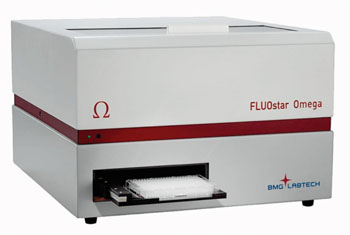Rapid Method Detects Creutzfeldt-Jakob Disease in Cerebrospinal Fluid
By LabMedica International staff writers
Posted on 05 May 2015
A long-standing problem in dealing with various neurodegenerative protein misfolding diseases is early and accurate diagnosis and this is particularly important with human prion diseases.Posted on 05 May 2015
Real-time quaking-induced conversion (RT-QuIC) assays of cerebrospinal fluid (CSF) and nasal-brushing specimens are valuable in distinguishing Creutzfeldt-Jakob Disease (CJD) from non-CJD conditions but require more than two days and up to five days to complete.

Image: BMG FLUOstar Omega plate reader (Photo courtesy of BMG LABTECH).
Scientists at the National Institutes of Health, (NIH; Hamilton, Montana, USA) and their colleagues obtained cerebrospinal fluid samples from patients with possible or probable Creutzfeldt-Jakob disease at the time of sampling, as well as from the patients with other neurologic disorders, including Alzheimer’s disease, amyotrophic lateral sclerosis, atypical Parkinsonism, dementia, dystonia, and seven other neurologic disorders.
RT-QuIC assays were performed on the CSF samples. Reaction mixtures was loaded into a black 96-well plate with a clear bottom and reaction mixtures were seeded with CSF for a final reaction volume of 100 µL. Plates were sealed and incubated in a BMG FLUOstar Omega plate reader (BMG LABTECH; Ortenberg, Germany; www.bmglabtech.com) at either 42 °C or 55 °C for 55 to 90 hours with cycles of 60 seconds of shaking and 60 seconds of rest throughout the incubation. Thioflavin T fluorescence measurements, excitation, 450 ± 10 nm; emission, 480 ± 10 nm, were taken every 45 minutes.
The improved RT-QuIC assay identified positive CSF samples within four to 14 hours with better analytical sensitivity. Moreover, analysis of 11 CJD patients demonstrated that while seven were RT-QuIC positive using the previous conditions, 10 were positive using the new assay. In these and further analyses, a total of 46 of 48 CSF samples from sporadic CJD patients were positive, while all 39 non-CJD patients were negative, giving 95.8% diagnostic sensitivity and 100% specificity.
The authors concluded that they had markedly improved RT-QuIC analysis of human CSF such that CJD and non-CJD patients can be discriminated in a matter of hours rather than days with enhanced sensitivity. These improvements should allow for much faster, more accurate, and practical testing for CJD. In broader terms, the study provides a prototype for tests for misfolded protein aggregates that cause many important amyloid diseases, such as Alzheimer’s, Parkinson’s, and tauopathies. The study was originally published on January 20, 2015, in the journal mBio.
Related Links:
US National Institutes of Health
BMG LABTECH








 (3) (1).png)
 assay.jpg)




